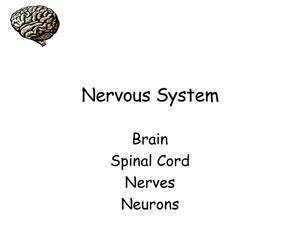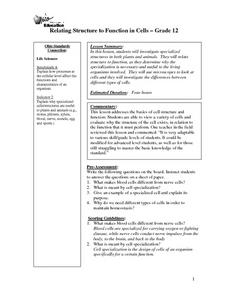Nerve Impulse Teacher Resources
Find Nerve Impulse lesson plans and worksheets
Showing 45 resources
TED-Ed
How Do Nerves Work?
This lesson won't get on your nerves! Find out how one kind of cell can cause comfort, terror, or pain in your brain. Comic strip and cartoon style animation is used to help explain the transmission of electrical nerve impulses and the...
Baylor College
Neural Network Signals
Using a simple circuit with the battery representing the brain, future physiologists test to see which solutions conduct electrical "nerve impulses." Enlighten learners with plentiful information on electric signals in the nervous system...
Curated OER
Nervous System
After reading through this presentation about nerve impulses, students should be able to complete the sentences given with the correct terms and scientific vocabulary. The basics of the ion channel behavior are detailed along with a...
Curated OER
AP: Chapter 48: Nervous System
Human anatomy enthusiasts trace neurological pahtways in word and on a diagram, describe action potential of a nerve impulse, and identify the organs in the nervous system. Provide this to your biology class as a review before...
Curated OER
Final Exam Practice - General Biology
A 17-page practice final exam for a college-level introductory biology course is contained in this resource. Matching and short answer questions cover every topic that you would expect to teach during an advanced biology course including...
TED-Ed
The Cockroach Beatbox
A neuroscientist explains, with the aid of creative and colorful animation and an actual cockroach leg, how the brain transmits and receives electrical messages. He uses electricity to cause the cockroach leg to move. This top-notch...
Curated OER
The Domino Effect
Students model the transmission of neural impulses with dominoes. In this nervous system instructional activity, students construct a device with dominoes. They use the device to model the way a nerve impulse is propagated from dendrite...
Curated OER
Role of the Sarcoplasmic Reticulum in Muscle Cells
Many of the concepts that are mentioned as an aside in previous videos are re-introduced here. By listening to Salman's recap of an action potential, students will understand how a nerve impulse can stimulate the release of...
Baylor College
Crossing the Synaptic Gap
As part of a unit on the chemistry of the brain, thinkers learn how chemicals work to transmit messages between individual neurons and how controlled substances impact the synaptic cleft. They do so by playing a dice-and-card game in...
Curated OER
Quick Concept Demonstrations
Students research the nervous system. Demonstrations on how to pick up keyed information in text is shown daily and weekly. Reviewed for content is Nerve Impulse, Polarization and Depolarization and perception. A spreadsheet will graph...
Curated OER
Review for Strand 2A Test: Nervous System
Three pages containing 51 true and false questions make up this nervous system review. The major topics listed at the top of the test mention a film strip and a laboratory activity, but the questions appear to be answerable without...
Curated OER
Achy, Breaky Nerve
High schoolers will develop models of neurons to understand the function of myelin as it applies to the normal and abnormal transmission of nerve impulses. In addition, the students will also have the opportunity to apply their knowledge...
Curated OER
Reflexes
Students experiment to explain how reflexes, nerve impulses travel to the brain.
Curated OER
Coordination
Multiple choice, fill-in-the-blank, short answer, and matching questions are all here in a multi-page worksheet or quiz. While the formatting leaves a little to be desired, it would take just a few minutes to change the handout into a...
Curated OER
Phylum mollusca
This is an organized presentation that lists characteristics and features of their general body features. Mollusc is spelt with both a 'c' and a 'k' in various stages of this Powerpoint so an explanation by the teacher of Scientific...
Curated OER
Relating Structure to Function in Cells
Twelfth graders investigate specialized structures in both plants and animals. They relate structure to function, as they determine why the specialization is necessary and useful to the living organisms involved. They use microscopes...
Curated OER
A Black Box Problem: How Do I Hear?
Young scholars assemble a diagram of the hearing pathway using information about its parts and their function, and predict the changes in hearing that might result from specific changes to the pathway.
Curated OER
The Action Potential
In this biology worksheet, students examine the internal functions of the human body while considering the factors needed to explain the physiological reactions.
Curated OER
Muscular System
For this muscular system worksheet, students define related terms of the muscular system, they identify types of muscles, they order the events of muscle contraction and given a clue about structures and function of the muscular system...
Curated OER
Action Potential: A Student Project
Students demonstrate their knowledge of action potential by creating an analogy and explaining this analogy to the class. They illustrate the action potential on paper by creating an analogy to demonstrate action potential and write or...
Curated OER
Tuned in: Tuning Forks and Sine waves
Students explore the characteristics of a pure sound wave produced by a tuning fork. They use sine waves to find a curve to fit the sound wave data produced by the tuning fork. A CBL and microphone is required for this activity.
Curated OER
Now You See It, Now You Don't
Young scholars determine their eye's blind spot. In this biology instructional activity, students explain what causes this visual deficiency. They give real life applications of this concept.
Curated OER
Cnidarians
In this cnidarians activity, high schoolers will read 4 descriptions and identify each as either the polyp or medusa form of cnidarian. Then students will complete 3 short answer questions about the characteristics of cnidarians....
Curated OER
Sponges, Cnidarians, Flatworms, and Roundworms
For this simple animals worksheet, students review the characteristics of sponges, cnidarians, flatworms, and roundworms. This worksheet has 12 matching questions.

























